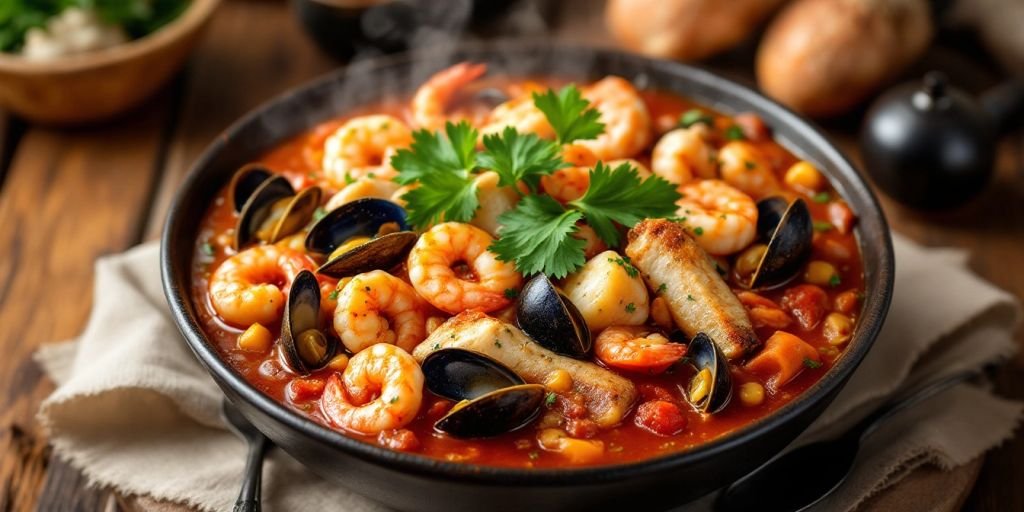Cioppino is a flavorful Italian-American stew that brings together a variety of fresh seafood in a delicious tomato and wine broth. This dish has deep roots in San Francisco, where it was created by fishermen using their daily catch. In this article, we will explore the history of cioppino, the essential ingredients needed for an authentic taste, and tips for making it perfectly every time.
Key Takeaways
- Cioppino originated from San Francisco’s Italian fishermen.
- Fresh seafood is key for the best flavor and texture.
- A rich tomato and wine broth is essential for authenticity.
- Let the stew simmer to enhance the flavors.
- Serve cioppino with crusty bread to soak up the delicious broth.
The Origins of Cioppino

San Francisco’s Fishermen Roots
Cioppino is a delicious seafood stew that was created by Italian immigrant fishermen in San Francisco during the late 1800s. This dish was made to use up the leftover catch from the day. It quickly became a favorite among locals and visitors alike, showcasing the bounty of the Pacific Ocean.
Italian Influence and Name
The name “Cioppino” is believed to come from the Ligurian word ciuppin, which means “to chop.” This reflects how the fishermen would chop up various types of seafood to create the stew. The roots of the dish and name are from Italy, and records of when this dish appeared vary from the Gold Rush days to the 1930s.
Evolution Over the Years
Over the years, Cioppino has evolved into a beloved dish not just in San Francisco but across the United States. It has adapted to include different types of seafood based on availability and personal preferences. Today, you can find many variations of Cioppino, but the heart of the dish remains the same: a rich tomato broth filled with fresh seafood.
Cioppino is more than just a meal; it’s a celebration of the sea and the community that brings it to the table.
Essential Ingredients for Authentic Cioppino
Choosing the Right Seafood
To create a delicious cioppino, you need to select the freshest seafood available. Here are some popular choices:
- Firm-fleshed fish: Halibut, cod, or salmon work well.
- Shellfish: Littleneck clams and shrimp are traditional favorites.
- Optional additions: Crab or mussels can enhance the dish.
Key Aromatics and Herbs
The flavor of cioppino comes from its aromatics and herbs. Make sure to include:
- Shallots and garlic: These are essential for a strong flavor base.
- Fresh herbs: Oregano and thyme add depth to the broth.
- Spices: A pinch of crushed red pepper flakes can give it a nice kick.
The Role of Wine and Tomatoes
Wine and tomatoes are crucial for the broth’s richness. Here’s how they contribute:
- White wine: Adds acidity and brightness, balancing the seafood flavors.
- Canned crushed tomatoes: Provide a rich, tangy base that makes the stew vibrant.
Tip: Always use high-quality ingredients for the best results. Fresh seafood and ripe tomatoes will make your cioppino truly shine.
Step-by-Step Guide to Making Cioppino
Preparing the Broth
To start your cioppino, heat olive oil in a large pot over medium heat. Add chopped shallots and cook until they are soft, about 5 minutes. Then, stir in minced garlic and cook for another minute. Next, pour in white wine and let it boil until reduced by half, which should take about 3-4 minutes. After that, add canned crushed tomatoes, clam juice, sugar, salt, red pepper flakes, oregano, thyme, and a cup of water. Bring this mixture to a boil, then reduce the heat and let it simmer for 25 minutes.
Cooking the Seafood
Once your broth is ready, it’s time to add the seafood. Start with the clams and mussels, cooking them until they open up. This usually takes about 5-7 minutes. After that, add shrimp and fish fillets, cooking gently until they are just about done. Turn off the heat and let the residual heat finish cooking the seafood. This helps prevent overcooking, which can ruin the texture.
Serving Suggestions
When serving cioppino, ladle it into bowls and top with fresh parsley for a pop of color. Serve it with crusty bread for dipping into the rich broth. This not only enhances the meal but also makes it more enjoyable. Don’t forget to provide extra bowls for shells and plenty of napkins!
Tips for the Best Cioppino
Using Fresh Seafood
To make the best cioppino, always choose fresh seafood. Fresh ingredients not only enhance the flavor but also ensure a delightful texture. Here are some tips:
- Visit your local fish market for the freshest catch.
- Look for seafood that smells like the ocean, not fishy.
- Choose a variety of seafood for a richer taste, such as shrimp, clams, and fish.
Balancing Flavors
A great cioppino has a perfect balance of flavors. Here’s how to achieve that:
- Start with a flavorful broth using aromatics like garlic and shallots.
- Add white wine to deglaze the pot and enhance the taste.
- Use canned crushed tomatoes for a rich base, but don’t forget to season with salt and pepper.
Make-Ahead and Storage Tips
Cioppino can be made ahead of time, which can actually improve its flavor. Here are some storage tips:
- Store leftovers in an airtight container in the fridge for up to 3 days.
- Reheat gently on the stove to avoid overcooking the seafood.
- You can freeze cioppino, but it’s best to add seafood fresh when reheating.
Remember, the key to a delicious cioppino is in the freshness of the ingredients and the time you allow the flavors to meld together. Enjoy your cooking!
Pairing Cioppino with Sides and Drinks

When enjoying a delicious bowl of cioppino, the right sides and drinks can elevate the experience. Here are some great options to consider:
Best Bread for Dipping
- Crusty Sourdough: Perfect for soaking up the rich broth.
- Garlic Bread: Adds a flavorful twist.
- Focaccia: Soft and great for dipping.
Complementary Salads
- Mixed Greens with Vinaigrette: Light and refreshing.
- Caesar Salad: A classic that pairs well with seafood.
- Italian Pasta Salad: Adds a hearty touch.
Wine Pairings
- Chardonnay: A crisp white wine that complements the seafood.
- Pinot Grigio: Light and fruity, enhancing the flavors of the stew.
- Sauvignon Blanc: Its acidity balances the richness of the broth.
Remember, the right sides and drinks can make your cioppino experience even better! Enjoying it with good company and the right accompaniments is key to a perfect meal.
By choosing the right bread, salads, and wines, you can create a delightful dining experience that highlights the flavors of your cioppino. Don’t forget to set out extra napkins for a mess-free meal!
Common Mistakes to Avoid When Making Cioppino
When making cioppino, it’s easy to make mistakes that can ruin this delicious seafood stew. Here are some common pitfalls to watch out for:
Overcooking the Seafood
- Seafood cooks quickly, so be careful not to leave it in the pot for too long. Overcooked seafood can become tough and rubbery.
- Add the seafood in stages, starting with the items that take longer to cook, like clams and mussels, followed by shrimp and fish.
- Remove the pot from heat just before the seafood is fully cooked; it will continue to cook in the residual heat.
Incorrect Seasoning
- Season your broth properly. A bland broth can make the whole dish unappetizing. Use salt, pepper, and herbs to enhance the flavors.
- Taste as you go! Adjust the seasoning gradually to avoid overpowering the dish.
- Remember that the freshness of your seafood will also affect the overall flavor, so choose high-quality ingredients.
Not Letting the Broth Simmer Long Enough
- A good cioppino needs time for the flavors to meld. Let the broth simmer for at least 25 minutes before adding the seafood.
- This simmering time allows the aromatics and spices to infuse the broth, creating a rich and flavorful base.
- If you rush this step, you might miss out on the depth of flavor that makes cioppino special.
To make the best cioppino, focus on timing and seasoning. These elements are key to achieving a perfect balance of flavors and textures.
Variations of Cioppino

Cioppino is a versatile dish that can be adapted to suit different tastes and ingredients. Here are some popular variations:
Regional Twists
- San Francisco Style: This is the classic version, featuring a mix of local seafood like crab, shrimp, and clams.
- Italian Coastal: In Italy, you might find cioppino made with Mediterranean fish and shellfish, reflecting local catches.
- Spicy Cioppino: Some recipes add a kick with extra red pepper flakes or spicy sausage for a different flavor.
Incorporating Different Seafood
Feel free to experiment with the types of seafood you use. Here are some ideas:
- Scallops: Swap out crab for scallops, adding them at the same time as the fish.
- Lobster: For a luxurious touch, include lobster tails.
- Squid: Adding squid can give a unique texture and flavor.
Adjusting for Dietary Preferences
- Vegetarian Cioppino: Use vegetable broth and a variety of vegetables instead of seafood.
- Gluten-Free: Ensure that any bread served on the side is gluten-free.
- Low-Carb: Serve cioppino over zucchini noodles instead of traditional pasta.
Remember, the beauty of cioppino lies in its flexibility. You can create a dish that suits your taste and the ingredients you have on hand. Enjoy experimenting!
Cioppino is a delicious seafood stew that has many different styles. Each version brings its own unique twist, making it a favorite for many. If you want to learn more about these tasty variations and discover some great recipes, visit our website today!
Final Thoughts on Perfecting Your Cioppino
In conclusion, making a delicious cioppino is all about using fresh ingredients and taking your time. This Italian seafood stew is not just a meal; it’s an experience that brings family and friends together. Remember to let the flavors blend well, and don’t rush the cooking process. Serve it with some crusty bread to soak up the tasty broth, and you’ll have a dish that everyone will love. So, gather your seafood, follow the tips shared, and enjoy creating your perfect cioppino!
Frequently Asked Questions
What is cioppino?
Cioppino is a hearty seafood stew that comes from Italian-American cuisine. It features a mix of fresh seafood cooked in a flavorful tomato and wine broth.
Where did cioppino originate?
Cioppino originated in San Francisco, created by Italian immigrant fishermen who used leftover fish and shellfish from their daily catch.
What seafood is best for cioppino?
The best seafood for cioppino includes firm fish like halibut, clams, shrimp, and even crab. You can mix and match based on what is fresh and available.
Can I prepare cioppino in advance?
Yes, you can make the broth ahead of time without the seafood. Just store it in the fridge and add the seafood when you’re ready to serve.
What should I serve with cioppino?
Cioppino is great with crusty bread for dipping, a fresh salad, and a nice glass of white wine.
How can I avoid overcooking the seafood in cioppino?
To avoid overcooking, add the seafood towards the end of cooking and let it finish cooking in the residual heat of the broth.




